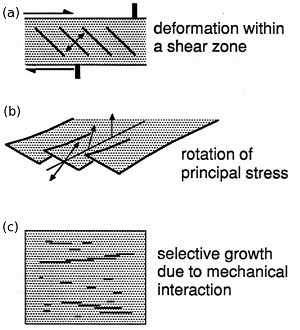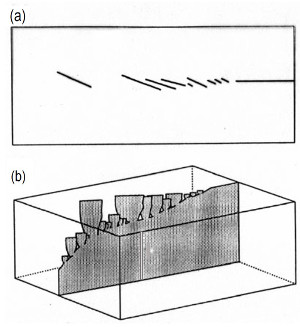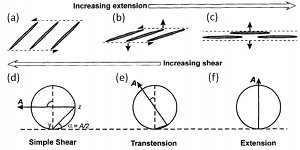| |||||||||
|
|
|||||||||
|
|
|||||||||
| Mechanisms and Mechanics of Echelon Joints | |||||||||
|
There are several models for the formation of echelon joints. Some of these are illustrated and the underlying mechanisms are listed in Figure 1. Each mechanism has been detailed under 'Riedel Shears,' 'Mixed-Mode Joint Propagation,' and 'Interaction of Joints.' Figure 1(a) shows a shear zone, the boundaries of which constrain the extent and distribution of the joints thereby producing a highly overlapped joint zone. Figure 1(b) shows an initially single joint breaking down to echelon joints as a result of mode I-III loading (Pollard et al., 1982; Pollard and Aydin, 1988). Figure 1(c) illustrates formation of echelon joint arrays due to interaction of neighboring joints which promotes selective growth of joints in certain alignments (Du and Aydin, 1991).
Figure 2(a) shows formation of echelon joint traces in front of a parent joint trace (Cruikshank et al., 1991). These may be considered as the 'Fringe Joints.' Figure 2(b) is a hypothetical block diagram by the same authors illustrating how such echelon joint arrays in 2(a) may be connected to the parent joint or sheared joint at depth.
Figure 3 shows progressive rotation of echelon joints making progressively smaller angles to the sheared boundaries (Kelly et al., 1998). | |||||||||
| Reference: |
|||||||||
| Cruikshank, K.M., Zhao, G., Johnson, A.M., 1991 Du, Y., Aydin, A., 1991 Kelly, P.G., Sanderson, D.J., Peacock, D.C.P., 1998 Pollard, D.D., Segall, P., Delaney, P.T., 1982 Pollard, D.D., Aydin, A., 1988 |
|||||||||
|
Readme | About Us | Acknowledgement | How to Cite | Terms of Use | Ⓒ Rock Fracture Knowledgebase |
|||||||||


